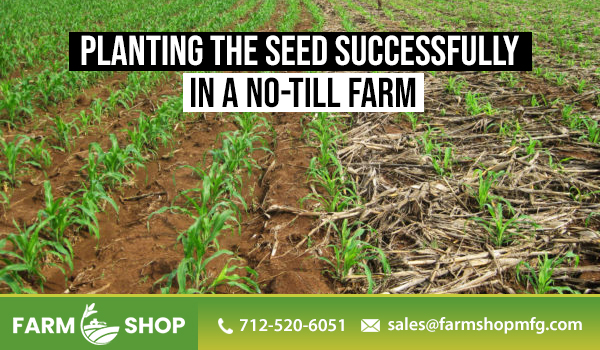The purpose of using planting equipment such as planters, drills, germinator closing wheels, and air seeders is to plant the seeds properly at optimum depth by cutting and handling the residue. Every piece of equipment needs adjustment before it is put to use, especially when it is a ‘no-till’ condition of the soil. Nowadays, many types of equipment, standard closing wheels, and planters are available that are used for no-till conditions of the soil. When planting the seeds in a no-till soil condition, then the main actions required are:
- Cutting through the residue
- Planting the seed down in the soil
- Maintaining seed-to-soil contact and closing the seed furrow
Cutting through the residue
Nowadays, planters and drills are manufactured that consist of large diameter, and disk seed furrow openers that make the no-till an easy job for the producers. Usually, the disks are manufactured using thick gauge steel because steel has the strength as well as lowers the risk of wear and tear.
In case the solid is highly erodible, then it is a good idea to keep the residue over the row in order to absorb raindrop impact. As a result, there will be low chances of erosion or crusting in the row. At the same time, the residue will prevent the seed vee from drying due to the presence of mulch. On the other hand, if the soil is flat and poorly drained, then row cleaners can be employed to remove the residue from the row and to prevent drying of the soil.
At times the wind may blow the residue back on the row. This interferes with the emergence of the plants from the seeds. As a result, the leaf comes out under the residue. Therefore, it is better to remove the residue from the soil so that the seedlings can come from the seed ‘V’ after planting.
In addition to that, if it is found that the soil is wet under the residue, the soil and residue will stick to the planter’s wheel and other equipment. Thus, many producers avoid residue movers in no-till farmland and let the planters move on soil having the layer of residue to avoid certain issues.
Planting the seed in the soil
In no-till farmland, the second step towards planting is to place the seed down through the residue, and in the soil. In moist soil, the seed should be placed at a proper depth of about 2 to 3 inches in the case of corn. This is required for the growth and development of roots. Therefore, the depth control is maintained a little deeper than normal as the depth gauge wheels have to move from a thick layer of residue over the soil.
A down pressure spring is required to maintain the desired seeding depth for penetration of the seed. The down pressure spring is helpful in transferring the weight from the planter toolbar to the individual row units equally.
If the gauge wheels are kept loose, then it is suggested that the down pressure springs should be tightened, or else heavy-duty springs can be added. Also, the toolbar should have enough weight so that the planter drive wheels are in firm contact with the soil. As a result, slipping can be prevented and the planter can be kept on the row.
Maintaining seed-to-soil contact and closing the seed furrow
Firming of the seed into the soil is done with a sufficient amount of weight on the press wheels. Wet soil tends to compact and overpacking of the soil should be avoided. Compaction and over-packing of the soil make it difficult for the emergence of the seedlings as well as the roots to penetrate the soil. Excessive weight on the depth gauge wheels can also lead to sidewall compaction in the wet soil. On the other hand, the presence of extra down pressure and closing force is necessary when the soil is in dry conditions.
Maintaining seed-to-soil contact is necessary for the germination and the emergence of the seed. Evaluation of the seed-to-soil contact must be done not only from the dop of the seed furrow but also when putting the down pressure on the press wheels. The down pressure must not be increased when there is proper seed-to-soil contact.
The use of the Germinator Closing Wheel (includes hub/rim) gives extra help in closing the seed furrow. The Germinator Closing Wheel is better in quality and performance than the traditional standard closing wheels, as it is made from high-grade quality steel. The Germinator Closing Wheels put lower down pressure on the soil and seed and effectively eliminate the sidewall compaction. They close the seed-vee while maintaining the proper depth of the and ensuring proper seed-to-soil contact.


